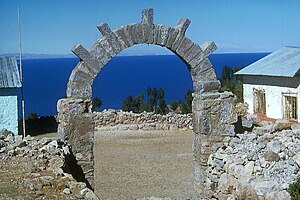| Amantaní | |
 | |
| State | Peru |
|---|---|
| Surface | 9.28 km² |
| Inhabitants | 3.663 (1988 census) |
Amantaní is an island of Titicaca lake belonging toPeruvian plateau.
To know
Amantaní is also called the "island of the Kantuta", because this plant grows in abundance on the island.
Geographical notes
Since the population lives on agriculture and pastoralism, the slopes of the mountains are terraced with stone walls where they grow wheat, quinoa, potatoes and goose (tuber widespread in the Andean area). Breeding is also practiced on similar terraces, in particular sheep and Andean camelids (such as llamas and alpacas).
In this circular island there are two peaks, the Pachatata (Heavenly Father) is Pachamama (mother Earth) on top of which there are ancient Inca and Tiwanaku ruins. The lake is called Pachakocha and represents the aquatic deity completing the representation of the cosmogony of the local religion concerning the natural elements.
Most of the inhabitants live in brick houses (adobe).
Spoken languages
The island's population belongs to the Quechua-speaking Aymara ethnic group, which is actively spoken by all ages. The Spanish it is mostly spoken among the much younger.

Territories and tourist destinations

How to get
How to get around
The island has no cars and is consequently closed to traffic, but it can be turned "comfortably" on foot.
What see
- Pachatata Temple. Located on the top of the Amantaní mountain, it is nothing more than a square-shaped drywall. You cannot enter it as access is allowed only to the community and only for a party that takes place on a day in the second half of January. The view from the top, however, is unparalleled especially if you arrive at the time of sunset.
Events and parties
- Annual party.
 One day in the second half of January. The day of the festival is the only day the temple of can be visited Pachatata. Also on this day the population of the island splits in two, with each group gathering at its respective temple. A race is then held by each peak at an intermediate point and a representative from each group is chosen for the competition. According to tradition, a win for Pachamama portends a bountiful harvest for the coming year.
One day in the second half of January. The day of the festival is the only day the temple of can be visited Pachatata. Also on this day the population of the island splits in two, with each group gathering at its respective temple. A race is then held by each peak at an intermediate point and a representative from each group is chosen for the competition. According to tradition, a win for Pachamama portends a bountiful harvest for the coming year.
What to do
Shopping
Similarly to the taquileños, the inhabitants of Amantaní are also known for their textiles, as well as their pottery.
How to have fun
Shows
The inhabitants of the island hold traditional dance performances at night for tourists who are offered to dress in their traditional clothes and participate. The women of the families also offer handmade alpaca hats for their visitors as a cover for the night breeze, and visitors are welcome to purchase them at the end of their stay.
Where to eat
As a drink, in addition to the widespread mate de coca, the muña, a local root infused for a few minutes in hot water. It tastes like mint but much stronger.
Where stay
Although there are no hotels, some families offer overnight accommodation and meals for tourists. In return, guests are required to bring food as gifts such as rice, sugar, cooking oil, fruit, etc .; while sweets are not recommended because dental treatment on the island is rare and expensive. Families who do this are required to have a special room reserved for tourists and must adapt to a code from the tour companies that help them.
Safety
There is a small clinic on the island.
How to keep in touch
Around
- Taquile - Another Peruvian island on the Titicaca, reachable with a short boat ride of about an hour.
